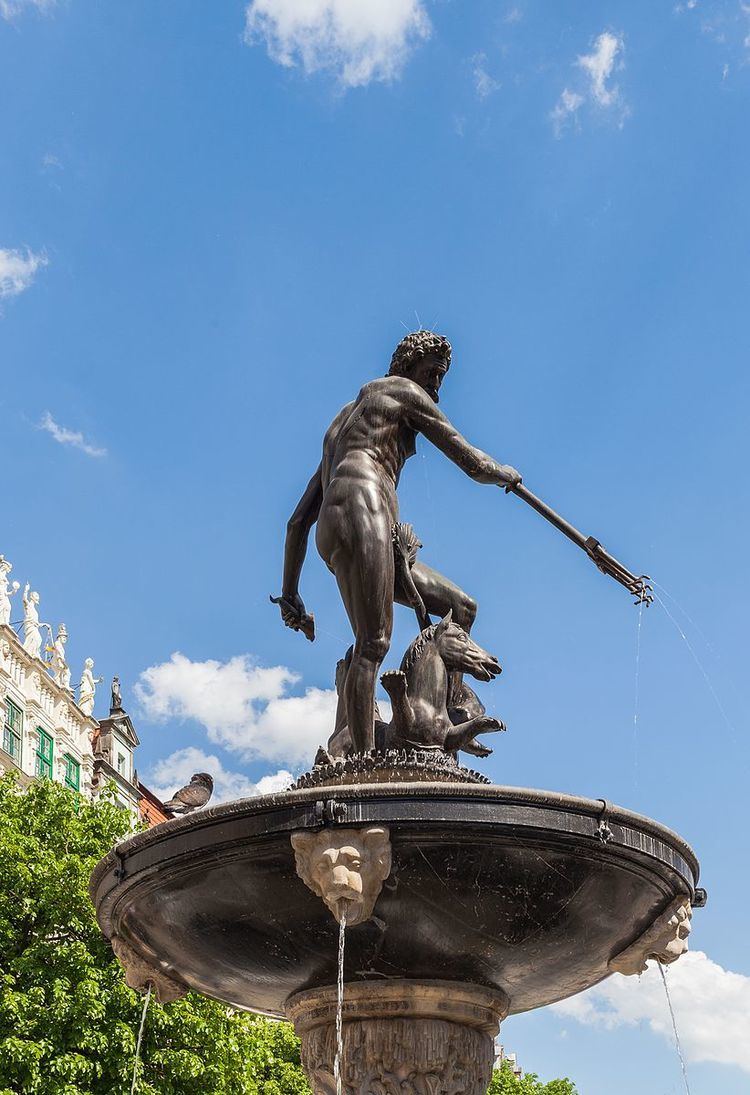Completed 1633 Construction started 1606 | Country Poland Opened 1633 | |
 | ||
Address Długi Targ, 80-833 Gdańsk, Poland Hours Open today · Open 24 hoursFridayOpen 24 hoursSaturdayOpen 24 hoursSundayOpen 24 hoursMondayOpen 24 hoursTuesdayOpen 24 hoursWednesdayOpen 24 hoursThursdayOpen 24 hoursSuggest an edit Similar St Mary's Church - Gdańsk, Long Lane - Gdańsk, Frauengasse, Artus Court, Long Market | ||
Neptune's Fountain - is a historic fountain in Gdańsk, which was constructed with the initiative of Mayor Bartłomiej Schachmann, and the local authorities. The fountain is located in the most notable part of Gdańsk - Long Market, by the entrance to Artus Court.
History
In 1549, by the entrance of Artus Court there was located a now unknown well, which may have had metal decorative pieces. The well was located slightly closer to the Motława.
The local authorities of Gdańsk, together with Mayor Bartłomiej Schachmann wanted to raise a more notable monument. The first mason to receive an offer to complete the project was Jakub Kordes from Lubeka, but for unknown reasons his plan was not accepted. The new fountain was to be constructed at the centre of the facade of the Artus Court, from the Green Gate the fountain would be seen with the Gdańsk Main Town Hall in the background, with the turn to the Long Lane. Neptune - the god of the sea - was to be placed facing the townhouses, which were the residence of the Polish kings, while at their stay in Gdańsk, the mythological god was to have his head bow down to them. The fountain was to have underground pumps connecting the fountain to the Potok Siedlecki by Sienny Market; however, the pressure was too low.
Between 1606 and 1615, there were pending projects, sculpturing, and casting. The sculpture's project was made by Abraham van den Blocke (born 1572, died 1628), with the statue made by Flemish Piotr Husen. The sculpture was cast from bronze in 1615, in the town casting guild in Gdańsk, by Gerdt Benning. The mass of the figure is 650 kilograms. The stem the figure is found on, is made from black tuff. The architectural features of the fountain relate to Flemish mannerism. The water installations were made by Ottomar von Wettner, with the water systems designed by Adam Wybe. The water tanks are located on the rooftop of the Gdańsk Main Town Hall and Artus Court. Formerly, the fountain was only operational in some days of the year, up until the second half of the nineteenth-century, after which Gdańsk had modernised its underground water system.
Formerly, the fountain was painted. The fountain was opened in October 9, 1633, the delay was caused due to numerous disruptions: the renovation of Artus Court; problems with the robustness of the water system; the Thirty Years' War; and the death of Abraham van den Blocke. The inauguration of the fountain's operation took place in March 23, 1634. Between the years of 1757 and 1761, Jan Karol Stender made new fragments of the fountain and stem, and meister blacksmith Jakub Barren had reconstructed and replaced the broken grate. This is when the fountain received its rococo architectural style.
In 1927, the fountain was renovated. The fountain was damaged during World War II, and moved to Parchów, located near Bytów; after World War II the tower was subsequently renovated and put back to operation in July 22, 1957. In 1988, as part of renovation works the fountain's genitals were covered with a fig leaf. A full renovation of the fountain occurred between September 2011 and April 2012.
